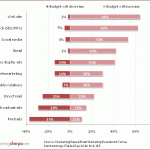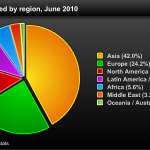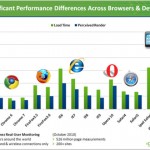No surprises here.
ROInternet
All the more reason to make sure your online presence is up to speed.
Is it just me, or are all health insurance websites sadistic leftovers from the 20th century? Do they really want you to find anything?
For example:
What kind of browser do I need to use myCIGNA?
myCIGNA has been tested for use with Microsoft Internet Explorer 6 and Internet Explorer 7. Other browsers can be utilized, however, full functionality cannot be guaranteed.
[Ed. Note: THIS WAS LAST YEAR ABOUT THIS TIME] Here are the browser requirements for BCBST.com. To protect you and your personal health information, BlueCross BlueShield of Tennessee requires a browser with 128-bit encryption strength in order to access the secure parts of our site. BCBST is serious about protecting our members’ privacy, and this level of encryption is an industry standard for the type of information we are exchanging.
Fully supported browsers for this site include Internet Explorer (IE) 4.01 to 6.01 and Netscape Navigator 4.1 to 4.72. Other browsers such as Firefox, Safari, Opera, AOL, etc. do not work correctly with our site and are not supported.
Continuing our annual tradition, below is our Top 10 Small Business Trends list for 2011. To see our past lists, click on the year: 2010, 2009, 2008.
Our overall economic outlook is for continued moderate growth with U.S. GDP increasing 3%-3.5%. While we expect hiring and the job market to improve, unemployment will remain stubbornly high, finishing the year around 9.2%.
Economic
1. The Small Business Economy Recovers from the Great Recession: Despite the Great Recession officially ending in 2009, and moderate overall U.S. economic growth in 2010, the small business sector of the U.S. was still in recession last year. We’re optimistic the economy will continue to improve in 2011 and economic growth will be more widespread. In 2011 small businesses will see stronger demand and better business conditions, resulting in the small business economy emerging from the Great Recession.
2. Variable Cost Business Models: Small businesses will continue to focus on cost containment, bootstrapping and business flexibility in 2011. More small businesses will shift from fixed cost to variable cost business models, adopting a pay-as-you-go approach to minimize cash requirements and increase business agility. Fixed costs and fixed assets will increasingly be avoided. Small business outsourcing and the use of contingent workers in place of full time employees will increase substantially.
3. Small Firms Reinvent U.S. Manufacturing: The recovering economy and 4 key trends are driving the growth of small and micro manufacturing, redefining how we think about manufacturing: (1) technology and variable cost business models are making it cheaper and easier for small and micro businesses to manufacture niche and customized products; (2) the weak dollar and rising overseas costs are making U.S. manufacturing cost competitive; (3) developing world economic growth is leading to stronger export opportunities; and (4) the Internet and online systems are improving the ability of small manufacturers to find, sell and support customers.
4. Alternative Financing: While the improving economy is leading to increased small business access to financing from banks and other traditional sources, capital will still be tight in 2011. This will lead to increased use of alternative credit sources – merchant advances, micro-lending, community lending, crowd funding, factoring, etc. Online micro-lending in particular will see a substantial increase in 2011.
Social and Social Media
5. Social Media Moves to the Small Business Mainstream: Despite the hype, the vast majority of small businesses haven’t used social media on a regular basis for business purposes. This is changing as small business users become more comfortable with social media, its benefits become clearer, and social media’s positive results become more obvious. The growth of social commerce (see 6below) and Facebook (see 7 below) are key drivers of the growing interest in and use of social media by small businesses.
6. Social Commerce:The amazing growth of Groupon
and other social commerce sites in 2010 heralded the shift towards the integration of social media and sales. 2011 will see this this field continue to explode as small businesses see clear, measurable, positive results from their social commerce/media efforts.
7. Small Businesses Friend Facebook: The epic growth of Facebook is hard to overstate. With over 500 million active users, including 200 million mobile users, Facebook has passed Google
and become the Web’s most visited site. Small businesses are embracing and adopting Facebook as a key part of their web presence, and in growing numbers using Facebook as their primary website.
8. New Localism Continues to Flourish: Driven by changing demographics, new technology, economic pressures and growing concerns about the environment, more Americans are focusing on their families, friends and local communities. Small businesses benefit from the growing number of locally-oriented customers and the opportunities created through “Buy Local” campaigns. New localism was on our list last year. It is a long-term trend whose impact has been accelerated by the recession and makes the list again this year because of its growing importance.
9. Freelancers Realize They’re Small Business Owners: The last few years have seen strong growth in the number of contingent workers – freelancers, part-timers, temps and contractors. Many of these new contingent workers are embracing freelancing and choosing to stay contingent. Others will stay contingent due to a lack of options. Both groups will increasingly see themselves as long term freelancers and realize to be successful they will need to view themselves as small business owners. This shift in thinking will improve their businesses and result in a stronger, more successful freelance community.
Technology
We see 2011 being a year of technology maturation and consolidation. By that we mean a number of technologies that have been impacting small businesses for several years are becoming mature and mainstream. Because of this, we are going to limit our technology trends to one broad trend.
10. Working in the Cloud: No trends list would be complete without mentioning mobile, cloud, local and social computing. While each of these trends is important, the growing convergence of these trends and technologies is amplifying their impact and fundamentally changing how business is done. Work is moving to the cloud, and small businesses are embracing this shift and related technologies.
#s 2, 8 and 10 especially.
In a recent meeting with a potential client here in flyover country, I got one of my first solid glimmers of the reset I see happening in small businesses. And that will accelerate in 2011.
This post was written by Aaron Levie
, CEO and co-founder of Box.net. His last guest post for us was “Building The Simple Enterprise.”.
On a recent call, an analyst shared a story about a company whose IT infrastructure was completely wiped out in a natural disaster. Forced to start from scratch, the company reinvented the spirit and composition of its enterprise IT strategy, and the set of solutions that emerged from the rubble made their organization inherently more mobile and efficient. Which begs the question: what would enterprise IT look like if all companies were afforded the opportunity to “start over?” In 2011, we might just find out. Other less destructive but incredibly powerful drivers for change are at work, and the coming year will be one of massive transformation in the enterprise.
The cloud has tipped for the enterprise
IDC forecasts that worldwide IT spending will hit $1.6 trillion this year, with 13% growth coming from software and services, and public cloud solutions making up the largest growth area. Cloud services are no longer on the periphery. 2011 will make this undoubtedly clear, bringing a massive wave of adoption, innovation and transformation as the cloud crosses the chasm from the early adopters to larger, more pragmatic organizations.
Evidence that the cloud has tipped is everywhere. It especially hit me when my dad, who works at a blue-chip paper company, told me that one of his business units had recently adopted NetSuite
. Microsoft has started advertising their cloud products at airports and on television. In 2010, the US government determined that Google
apps is secure enough for the GSA and Microsoft’s BPOSS for the USDA, citing millions in cost savings annually. Even Larry Ellison, one of the cloud’s biggest detractors, opened his Oracle Openworld keynote talking about, well, cloud computing.
Suffice it to say, we’re in the middle of one of the most important computing shifts in history. And as has happened before with other major paradigm transitions, new businesses will emerge to define and dominate markets. Apple and Microsoft took over as we moved from Mainframe to Personal. Google’s power grew alongside the rise of the consumer internet era. Facebook is owning social. We know the drill. We will look back on this period with wonder, when five years from now managing your own servers and infrastructure will seem about as quaint as when Bill Gates supposedly said, “No one will need more than 637KB of memory.”
Cloud in the enterprise is a classic disruption story. It began as a way to deliver lower-end applications that we didn’t yet care about or know we needed. Most incumbent vendors ignored or tried to delay the early indicators. But that’s how all disruption stories start: from the low end, and as the technology matures – more security, uptime, traction – the wave builds momentum. Soon, the enterprise wakes up to the fact that this approach to doing business and IT is not only more time and cost effective, it’s transforming the way their organization operates.
The first cloud deployment in a large enterprise is always the greatest hurdle, but once Walmart implements SuccessFactors
for performance management or Chiquita’s CIO decides that Workday is reliable enough to be its system of record for HR, there’s very little holding these organizations back from moving other non-core systems to outside vendors.
And their cloud adoption paves the way for others, creating a ripple effect through organizations of all sizes. If you had surveyed the market a year ago you’d have found many enterprises still wary about the state of cloud solutions for their business, but we’re now seeing the inverse become true: enterprises are no longer comfortable with investing in on-premise systems when trusted web-based alternatives exist.
Just as mainframe computing became obsolete when personal computers and servers matched their power far more efficiently, today’s big iron IT infrastructure may well see its own obsolescence for the majority of needs. In fact, perhaps the most prescient quote of all was from Thomas J. Watson, former president of IBM, when he said, “I think there is a world market for maybe five computers.” He was just about 60 years too early.
The mobile enterprise will finally be realized
Mobility is creating major demand for cloud offerings today, and is a disruptive force on its own. In last year’s summer earnings call, Apple COO Tim Cook shared that, “…in the first 90 days, we already have 50% of the Fortune 500 that are deploying or testing the iPad.” In 2010, AT&T said that nearly 40% of iPhone sales were going to businesses and enterprises, with the most relative growth in enterprise market share coming from Android devices in 2010.
As Aberdeen’s Andrew Borg points out, these devices aren’t completely enterprise ready, yet it doesn’t take much clairvoyance to see that this trend will continue to gain momentum in 2011; and with greater diversity of sophisticated mobile devices in the enterprise comes completely new opportunities for disruption.
For these new devices to be fully corporate-ready, they need seamless access to email systems, business data and intelligence, communication tools, and more. The cloud rewrites the rules here, enabling new handsets and tablets to connect to the “grid” like any other computer, something that is finally making the mobile workplace a reality. And with the truly mobile workforce, completely new computing cases are emerging.
Remote sales teams are pulling down inventory or product information from the cloud while on-site with just their iPad in hand. Construction workers on rooftops are viewing up-to-date digital blue prints from the main office. Good luck doing that with SharePoint
. Mobile devices are becoming a catalyst for completely new enterprise applications, and vice versa. The marriage of the two is so uniquely powerful that businesses will experience a wave of productivity transformation over the next few years.
The polygamous enterprise and the fall of Microsoft monogamy
While enterprises of prior decades may have gotten by predominantly on a combination of software developed in Redmond and Redwood Shores, this won’t be the case for the enterprise in 2011. The mandate of the modern enterprise IT department is transitioning from maintaining and upgrading systems from a limited set of vendors, to piloting and implementing a diverse set of services to solve problems.
We’re even seeing this shift on the hardware side, as Macs enter corporations in greater proportions, seeing double and in some cases triple digit growth within large enterprises and the government. The era of near-religious adoption of vertically integrated tools from behemoth vendors is coming to an end, providing an unprecedented opening for best-of-breed solutions to compete for enterprise customers.
Microsoft will likely be the most affected party, but enterprises in 2011 will start to feel both the upsides and management strain immediately. With the floodgates open for new and heterogeneous solutions, we’ll continue to see massive adoption of technology directly from employees themselves. This is quickly becoming the fastest entry point for new software and hardware, and these tools aren’t being immediately turned off by IT.
During an audience survey at this year’s Dreamforce conference half the group said they had SharePoint in their organization; yet when asked how many were looking to switch off SharePoint in the coming year, more than half of the group kept their hands up. Ballmer and company are still trying to figure out how to operate in a world that isn’t centered around them, and the rise of cloud and mobile is producing just exactly that. Microsoft—a company that has traditionally grown through complexity and new product lines—is going to have to fight to stay competitive.
Social and personalization will permeate all business apps
All this variety would normally create chaos, except that these applications are becoming connected in incredibly powerful ways. They’ll work harder for us, surfacing more relevant information for a passive user than an active user could ever possibly discover in their silo-ed legacy software.
Social capabilities will transform how we interact with our applications, and not just within the category of enterprise social software, which is finally beginning to move from the periphery to mainstream, with Gartner estimating a $1B market size in 2011. To get much further than this, Rob Koplowitz of Forrester points out that business value has to be established, and organizations must learn to embrace a different kind of risk, suggesting there’s more danger today by not sharing enough than having too much transparency.
This is not just about our software becoming more social in the contemporary sense, with status messages and communication between users. It’s about our software becoming much more personalized for our job functions, and being smarter than us in the areas it has more knowledge. Your content management solution should surface information and collaborators that are relevant to your current projects.
Your social software platform should recommend experts for a team you’re putting together without being prompted. LinkedIn should tell you what candidates fit the position for which you’re hiring. And as the business social layer continues to grow, a rich ecosystem of applications that connect to one another will emerge. This will lead to the ability to write mashups on top of our business social software, have viral business applications that live on top of the “graph,” and an enterprise experience in 2011 that is far more personalized and contextual to our own work behaviors.
The disruption story of cloud in the enterprise is still in its early chapters, but in 2011 it will be impossible to deny. Don’t be surprised if the rise of mobility, the fall of vendor hegemony, and the spread of social capabilities across all business applications creates massive upheaval in the enterprise software market—more than we’ve seen in the past five years combined. (I may be biased here since I run an enterprise cloud startup, but I may also be right).
It will also create short-term challenges for IT departments as they find their footing in a world with more applications and devices to manage than ever before, but with a long-term upside of significantly reduced system maintenance and a role that is inherently more strategic and dynamic. For users, however, this disruption only brings benefits. The devices they want to use are finally the ones they’re being armed with, and thanks to cloud applications, they can now work from anywhere.
The technology they’re using is best-of-breed rather than chosen by default or vendor lock-in. And the social capabilities that have revolutionized their personal lives are now being applied to their work lives in ways that are arguably even more powerful. Welcome to 2011.
Photo credit: Flickr/Jennifer Konig
Website: box.net Location: Palo Alto, California, United States Founded: 2005 Funding: $29.6M After starting as a college business project in 2005, Box.net was officially launched in March of 2006 with the vision of connecting people, devices and networks. Box.net provides more than 4 million users with secure cloud content management and… Learn More
Information provided by CrunchBase
I absolutely feel this happening, although I see it more on an individual level in my neck of the woods, but it’s coming nonetheless.
*Best of 2010: Consumer Spending Forecasts*
The average online shopper delays making a purchase by almost two days after initially visiting a retail site, according to data from a leading Internet security company.
After monitoring the shopping behavior of 163 million consumers completing 2.52 million transactions, McAfee SECURE discovered that the average customer waited 33 hours and 54 minutes, or nearly two days, between first visiting a retail site and making a purchase. In 64% of the cases, the shopper waited at least one day to buy.
This seemingly cautious behavior, which McAfee calls “digital window shopping,” is really a somewhat normal shopping behavior wherein a potential customer loads items into a shopping cart and then leaves the retailer’s site in search of more information, price comparison data, or even information about the merchant to ensure that the transaction and any customer service will be handled well.
Cost Concerns
Some 46% of consumers surveyed in 2009 by PayPal and comScore, said that they did not complete an online transaction because the shipping charges were too high. Some 37% of that same group wanted to compare the prices and the shipping charges across more than one merchant, and 27% of those surveyed left the cart to look for a coupon code.
It may well be that these customers later returned and made the purchase, but addressing concerns during the checkout could convert window shoppers into immediate buyers.
To overcome cost concerns, merchants should:
- Use dynamically generated shipping rates that provide the best possible rate data and consider offering shipping discounts based on order size. The discount offer should be included on the checkout page.
- Include a list of popular coupon codes in the shopping cart.
- Offer a price guarantee so that shoppers won’t feel the need to compare prices.
Service Challenges
Approximately 24% of those surveyed left the shopping cart because they could not find their preferred payment method, while some 22% left because they were not sure how to ask a question or contact customer service.
These sorts of service objections are very easy to assuage:
- Do your best to accept nearly every valid form of payment, including credit cards, electronic checks, PayPal, and Google Checkout, to name some. Getting the payment should not be the barrier to getting the sale.
- Include customer service links and data on the checkout page. Be sure to include links that open in new tabs or windows when possible.
Security Concerns
Finally, about 21% of shoppers left a shopping cart because they were concerned about the safety of their personal or credit card information.
This hurdle could be the most troublesome, since it implies that the retailer has not done a good enough job of assuring the customer that it is a legitimate and trustworthy business.
But even these concerns can be addressed.
- Consider adding third party trust marks that provide an unbiased assurance that your site is safe and that your business and privacy policies match the industry’s best practices.
- Add SSL verification to encrypt transactions and to free your site from hackers.
- Have a well designed website, as nothing demonstrates professionalism and trustworthiness better than good site design.
Digital Window Shopping: The Long Journey to “Buy”. McAfee SECURE. Apr. 2010. Web. 16 Apr. 2010.
There’s still friction when it’s time for customers to hit the buy button.
Just one of several useful charts. Another points out that, the more tech-savvy your customer base, the more you need to pay attention to Chrome, Firefox and Safari.








